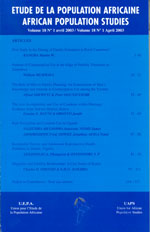
|
African Population Studies
Union for African Population Studies
ISSN: 0850-5780
Vol. 29, No. 2, 2015, pp. 1843-1850
|
 Bioline Code: ep15025
Bioline Code: ep15025
Full paper language: English
Document type: Research Article
Document available free of charge
|
|
|
African Population Studies, Vol. 29, No. 2, 2015, pp. 1843-1850
| en |
Adequacy of Technical Facilities for Maternal Health Care Delivery in Public Secondary and Tertiary Facilities in Osun State, Nigeria
Asa, Soladoye S.; Fatusi, A.O.; Ilori, M.O. & Osagbemi, Kayode
Abstract
Nigeria has one of the highest maternal mortalities and morbidities in the world, and the need to address these challenges continues to engage the attention of relevant stakeholders but very little attention has focused on technological resources within the maternal health research agenda. This study aims to identify and determine the adequacy of the key equipment for emergency obstetric care (EmOC) services in public-sector secondary and tertiary health facilities in Osun State, Southwest, Nigeria. Using a two-stage probability sampling procedure, 7 health facilities based in 6 randomly selected Local government areas (LGAs) were involved in the study. Data were obtained through the use of primary and secondary sources. For primary sources, a questionnaire was administered to 112 health workers and the study also utilized a checklist for equipment inventory. For secondary sources we reviewed existing hospital records on technology acquisition and maintenance. Relevant descriptive and inferential statistics were used for the data analysis. Almost three-fifths (58.1%) of the health workers considered the technical facilities for the delivery of EmOC in their facilities as inadequate, the proportion of health workers with such opinion was significantly higher in secondary compare to tertiary facilities (60.0% vs 40.0%, p=0.003). The inventory review and use of the checklist also showed varying degree of inadequate technical facilities; none of the facilities had all the 26 equipment considered as essential for comprehensive EmOC in functional state. We concluded that the public sector facilities in Osun State have inadequate technical facilities for EmOC; addressing this technological challenge will be critical to improving maternal health outcomes and statistics in Nigeria.
Keywords
Emergency Obstetric Care; Secondary Healthcare Facilities; Tertiary Healthcare Facilities; Technology Acquisition; Technical Facilities
|
| |
| fr |
Asa, Soladoye S.; Fatusi, A.O.; Ilori, M.O. & Osagbemi, Kayode
Résumé
Le Nigeria a l’un des taux de mortalité et de morbidité maternelle les plus élevés au monde. Même si les parties intéressées sont attentives au besoin de palier à ce fléau, peu d’attention a été dévolue au ressources techniques dans les études et recherches concernant la sante maternelle. Cette étude essaie d’identifier et de déterminer l’adéquation des équipements-clés de soins obstétriques d’urgence (EmOC) dans le secteur public secondaire et tertiaire des établissements de santé dans l’Etat d’Osun, au Sud-Ouest du Nigeria. Utilisant un échantillonnage de probabilité à deux temps, 7 établissements de santé se situant dans 6 zones de gouvernance locale (LGAs) choisis au hasard ont fait l’objet de cette étude. Les données ont été obtenues grâce à un formulaire rempli par 112 professionnels de santé et un inventaire des équipements disponibles, en plus de sources secondaires (un examen des fichiers des hôpitaux sur l’acquisition et la maintenance des équipements). Des statistiques descriptives et différentielles sont utilisées pour analyser les données. Presque les 3/5 (58,1%) des professionnels de la sante considèrent que les infrastructures techniques d’offre de soins obstétriques d’urgence (EmOC) sont inadéquats. La proportion des professionnels qui sont de cette opinion est beaucoup plus élevée pour les structures secondaires que tertiaires (60,0% contre 40,0%, p=0,003). La revue de l’inventaire et l’étude des listes d’équipements disponibles aussi montre à des degrés divers l’inadéquation des plateaux techniques pour les soins obstétriques d’urgence; aucune des infrastructures n’a toutes les 26 machines considérées comme essentielles pour de tels soins dans un Etat qui fonctionne normalement. Nous concluons que les infrastructures publiques dans l’Etat d’Osun sont inadéquates pour la provision de soins obstétriques d’urgence. Palier à ces difficultés techniques est crucial pour améliorer la santé maternelle au Nigeria..
Mots Clés
Soins Obstétriques d’Urgence; Etablissements Sanitaires Secondaires; Etablissements Sanitaires Tertiaires; Acquisition Technique; Infrastructures Sanitaires
|
| |
© Copyright 2015 - African Population Studies
Alternative site location: http://www.uaps-uepa.org
|
|
